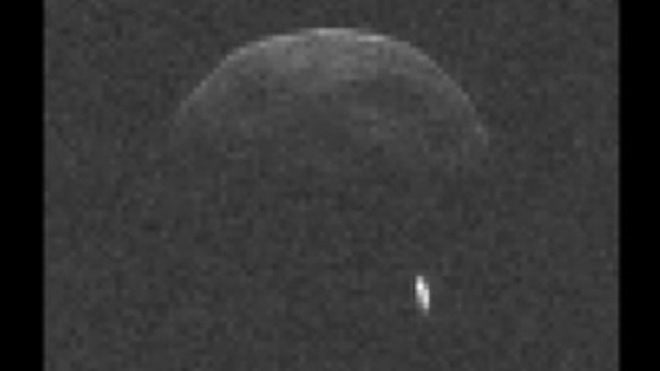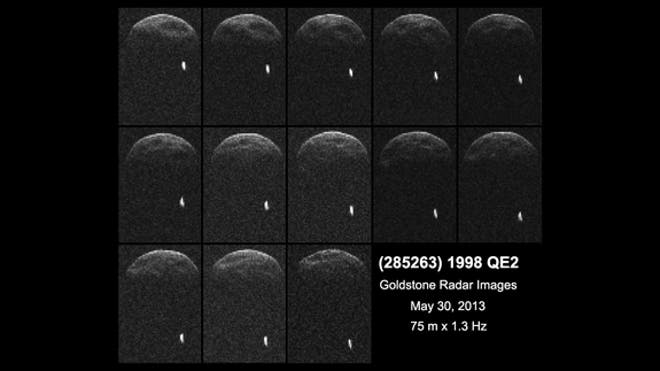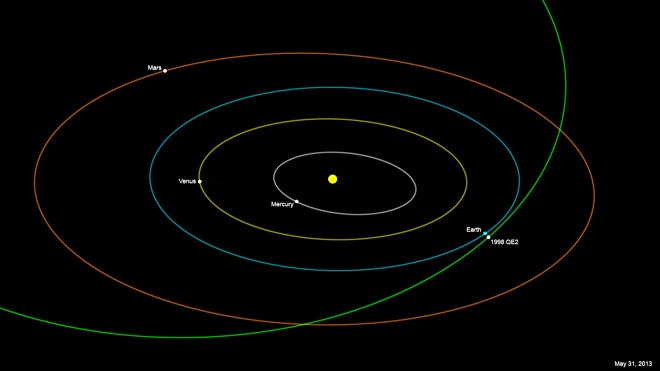Results 1 to 6 of 6
Thread Information
Users Browsing this Thread
There are currently 1 users browsing this thread. (0 members and 1 guests)
Hybrid View
-
05-17-2013, 11:54 AM #1
Dark, massive asteroid to fly by Earth on May 31
Dark, massive asteroid to fly by Earth on May 31
By Deborah Netburn
May 17, 2013, 7:00 a.m.
It's 1.7 miles long. Its surface is covered in a sticky black substance similar to the gunk at the bottom of a barbecue. If it impacted Earth it would probably result in global extinction. Good thing it is just making a flyby.
Asteroid 1998 QE2 will make its closest pass to Earth on May 31 at 1:59 p.m. PDT.
Scientists are not sure where this unusually large space rock, which was discovered 15 years ago, originated from. But the mysterious sooty substance on its surface could indicate it may be the result of a comet that flew too close to the sun, said Amy Mainzer, who tracks near-Earth objects at Jet Propulsion Laboratory in La Cañada Flintridge. It might also have leaked out of the asteroid belt between the orbits of Mars and Jupiter, she said.
We will know more after the asteroid zips closer to Earth and scientists using the Deep Space Network antenna in Goldstone, Calif., and the Arecibo Observatory in Puerto Rico can get a better look at it. Astronomers at both observatories plan to track it closely from May 30 to June 9, according to a JPL release.
At its closest approach the asteroid will still be 3.6 million miles from our planet (about 15 times the distance between the Earth and the moon), but it will be close enough for these powerful radar antennas to see features as small as 12 feet across.
"With radar we can transform an object from a point of light into a small world with its own characteristics," Lance Benner, JPL's principal investigator for Goldstone radar observations, said in a statement.
There is no chance that asteroid 1998 QE2 could collide with Earth this go-around, and its next close approach won't be until 2119.
Still, Mainzer said the size of the asteroid, and its potential for mass destruction, should remind us that there are some scary things flying around in space.
"This is a really big asteroid, similar in size to the one that killed off the dinosaurs, and it's getting very close to us," she said. "Fortunately we've been tracking its orbit very carefully so we know with great certainty it won't hit us.
"We don't need to panic, but we do need to pay attention," she said.
http://www.latimes.com/news/science/...0,548201.storyNO AMNESTY
Don't reward the criminal actions of millions of illegal aliens by giving them citizenship.
Sign in and post comments here.
Please support our fight against illegal immigration by joining ALIPAC's email alerts here https://eepurl.com/cktGTn
-
05-17-2013, 04:40 PM #2
Huge Rock Crashes Into Moon, Sparks Giant Explosion
 By Clara Moskowitz | SPACE.com – 5 hrs ago
By Clara Moskowitz | SPACE.com – 5 hrs ago
Related Content
prevnext
View PhotoThis artist's illustration shows …
View PhotoThis photo shows the bright flash …
View PhotoNASA's lunar monitoring program …
The moon has a new hole on its surface thanks to a boulder that slammed into it in March, creating the biggest explosion scientists have seen on the moon since they started monitoring it.
The meteorite crashed on March 17, slamming into the lunar surface at a mind-boggling 56,000 mph (90,000 kph) and creating a new crater 65 feet wide (20 meters). The crash sparked a bright flash of light that would have been visible to anyone looking at the moon at the time with the naked eye, NASA scientists say.
"On March 17, 2013, an object about the size of a small boulder hit the lunar surface in Mare Imbrium," Bill Cooke of NASA's Meteoroid Environment Office said in a statement. "It exploded in a flash nearly 10 times as bright as anything we've ever seen before." [The Greatest Lunar Crashes Ever]
NASA astronomers have been monitoring the moon for lunar meteor impacts for the past eight years, and haven't seen anything this powerful before.
Scientists didn't see the impact occur in real time. It was only when Ron Suggs, an analyst at NASA's Marshall Space Flight Center in Huntsville, Ala., reviewed a video of the bright moon crash recorded by one of the moon monitoring program's 14-inch telescopes that the event was discovered.
"It jumped right out at me, it was so bright," Suggs said.
Scientists deduced the rock had been roughly 1-foot-wide (between 0.3 to 0.4 meters) and weighted about 88 lbs (40 kg).The explosion it created was as powerful as 5 tons of TNT, NASA scientists said.
When researchers looked back at their records from March, they found that the moon meteor might not have been an isolated event.
"On the night of March 17, NASA and University of Western Ontario all-sky cameras picked up an unusual number of deep-penetrating meteors right here on Earth," Cooke said. "These fireballs were traveling along nearly identical orbits between Earth and the asteroid belt."
Though Earth's atmosphere protected our planet's surface from being hit by these meteors, the moon has no such luck. Its lack of an atmosphere exposes it to all incoming space rocks, and the NASA monitoring program has spotted more than 300 meteor strikes that reached its surface since 2005.
Part of the motivation for the program is NASA's eventual intent to send astronauts back to the moon. When they arrive, they'll need to know how often meteors impact the surface, and whether certain parts of the year, coinciding with the moon's passage through crowded bits of the solar system, pose special dangers.
"We'll be keeping an eye out for signs of a repeat performance next year when the Earth-Moon system passes through the same region of space," Cooke said. "Meanwhile, our analysis of the March 17th event continues."
The scientists also hope to use NASA's Lunar Reconnaissance Orbiter to photograph the impact site to learn more about how the crash occurred.
http://news.yahoo.com/huge-rock-crashes-moon-sparks-giant-explosion-152049489.html;_ylt=Am2tZbeLpRTOWHml_lh5vTWs0NUE;_ ylu=X3oDMTUycDB1bzBzBGNjb2RlA2dtcHRvcDEwMDBwb29sd2 lraXVwcmVzdARtaXQDTmV3cyBGb3IgWW91IDUgU3RvcmllcwRw a2cDMGY4ODIyOTItMWE0NS0zYzUzLTgzOGItYTgzZjliMDY4NT RmBHBvcwMxBHNlYwNuZXdzX2Zvcl95b3UEdmVyAzg0MTI2MzEx LWJmMDctMTFlMi1iMzMzLWY5MDk1MWFiZjA0Yg--;_ylg=X3oDMTBhYWM1a2sxBGxhbmcDZW4tVVM-;_ylv=3Last edited by JohnDoe2; 05-17-2013 at 04:43 PM.
NO AMNESTY
Don't reward the criminal actions of millions of illegal aliens by giving them citizenship.
Sign in and post comments here.
Please support our fight against illegal immigration by joining ALIPAC's email alerts here https://eepurl.com/cktGTn
-
05-18-2013, 04:54 PM #3
Bigger than an ocean liner, asteroid 1998 QE2 will zip by Earth this month
The giant asteroid, named 1998 QE2, will fly by at an estimated 3.6 million miles from Earth. NBC's Brian Williams reports.
By Mike Wall
Space.com
A big asteroid will cruise by Earth at the end of the month, making its closest approach to our planet for at least the next two centuries.
The May 31 flyby of asteroid 1998 QE2, which is about 1.7 miles (2.7 kilometers) long, poses no threat to Earth. The space rock will come within 3.6 million miles (5.8 million km) of our planet — about 15 times the distance separating Earth and the moon, researchers say.
But the close approach will still be dramatic for astronomers, who plan to get a good look at 1998 QE2 using two huge radar telescopes — NASA's 230-foot (70 meters) Goldstone dish in California and the 1,000-foot (305 m) Arecibo Observatory in Puerto Rico. [Photos: Asteroids in Deep Space]
"Whenever an asteroid approaches this closely, it provides an important scientific opportunity to study it in detail to understand its size, shape, rotation, surface features and what they can tell us about its origin," Lance Benner of NASA's Jet Propulsion Laboratory in Pasadena, Calif., principal investigator for Goldstone radar observations, said in a statement.
"We will also use new radar measurements of the asteroid's distance and velocity to improve our calculation of its orbit and compute its motion farther into the future than we could otherwise," Benner added.
Asteroid 1998 QE2 was discovered in August 1998 by astronomers working with MIT's Lincoln Near Earth Asteroid Research (LINEAR) program in New Mexico.
The space rock's name is not an homage to England's Queen Elizabeth II, or to the famous 12-deck ocean liner that was retired from service in 2008. It's just the moniker assigned by the Minor Planet Center in Cambridge, Mass., which names each newfound asteroid according to an established alphanumeric scheme that lays out when it was discovered.
Astronomers plan to study 1998 QE2 intensively from May 30 through June 9, using the Goldstone and Arecibo dishes to learn as much as possible about the asteroid before it slips off once more into the depths of space.
as much as possible about the asteroid before it slips off once more into the depths of space.
Even from about 4 million miles (6.4 million kilometers) away, Goldstone images may be able to resolve features on 1998 QE2 as small as 12 feet (3.75 meters) across, researchers said.
"It is tremendously exciting to see detailed images of this asteroid for the first time," Benner said. "With radar we can transform an object from a point of light into a small world with its own unique set of characteristics. In a real sense, radar imaging of near-Earth asteroids is a fundamental form of exploring a whole class of solar system objects."
of solar system objects."
NASA leads the global effort to identify potentially dangerous asteroids. Our planet has been pummeled by space rocks throughout its 4.5-billion-year history, and more strikes are in our future.
The planet got a dramatic reminder of this reality this past Feb. 15. On that day, a 55-foot (17-m) object exploded without warning over Russia, just hours before the 130-foot asteroid 2012 DA14 gave Earth a close shave, missing our planet by just 17,200 miles (27,000 km).
http://science.nbcnews.com/_news/2013/05/17/18320991-bigger-than-an-ocean-liner-asteroid-1998-qe2-will-zip-by-earth-this-month?liteNO AMNESTY
Don't reward the criminal actions of millions of illegal aliens by giving them citizenship.
Sign in and post comments here.
Please support our fight against illegal immigration by joining ALIPAC's email alerts here https://eepurl.com/cktGTn
-
05-30-2013, 12:14 AM #4
Asteroid as big as nine cruise ships to sail past Earth
On May 31, an asteroid as big as nine cruise ships will sail past Earth. There is no cause for concern, however, as the asteroid is expected to miss the Earth by approximately 3.6 million miles, which is about 15 times the distance between Earth and the moon. . .Science Recorder - 25 minutes ago NO AMNESTY
Don't reward the criminal actions of millions of illegal aliens by giving them citizenship.
Sign in and post comments here.
Please support our fight against illegal immigration by joining ALIPAC's email alerts here https://eepurl.com/cktGTn
-
05-30-2013, 03:55 PM #5
GOOD LUCK TOMORROW.
 NO AMNESTY
NO AMNESTY
Don't reward the criminal actions of millions of illegal aliens by giving them citizenship.
Sign in and post comments here.
Please support our fight against illegal immigration by joining ALIPAC's email alerts here https://eepurl.com/cktGTn
-
05-31-2013, 11:56 AM #6
Giant asteroid to sail past Earth today: watch it live here
By Mike Wall
Published May 31, 2013
Space.com

May 29, 2013: One of a sequence of radar images of asteroid 1998 QE2, which makes its closest pass by the Earth Friday evening. (NASA/JPL-Caltech/GSSR)

The Virtual Telescope Project in Italy captured this view of the huge asteroid 1998 QE2 on May 30, 2013. (Gianluca Masi/Virtual Telescope Project (www.virtualtelescope.eu))

First radar images of asteroid 1998 QE2 were obtained when the asteroid was about 3.75 million miles (6 million kilometers) from Earth. (NASA/JPL-Caltech/GSSR)

On May 31, 2013, asteroid 1998 QE2 will sail serenely past Earth, getting no closer than about 3.6 million miles, or about 15 times the distance between Earth and the moon. (NASA/JPL-Caltech)
Next Slide Previous Slide
A huge asteroid is set to cruise by Earth Friday afternoon, making its closest approach to our planet for at least the next two centuries.
Asteroid 1998 QE2 will come within 3.6 million miles of Earth at 4:59 p.m. EDT (2059 GMT) Friday — about 15 times the distance from our planet to the moon.
will come within 3.6 million miles of Earth at 4:59 p.m. EDT (2059 GMT) Friday — about 15 times the distance from our planet to the moon.
There's no chance the 1.7-mile-wide 1998 QE2 will hit us, researchers say. That's a good thing, because a strike by such a big space rock would cause catastrophic damage, potentially wiping out our species. [Potentially Dangerous Asteroids (Images) ]
]
'Asteroids of this size have changed the biosphere of our planet in the past.'- Astronomy magazine columnist Bob Berman
In general, scientists think any asteroid bigger than 0.6 miles could end human civilization if it hit us. For comparison, the object that killed off the dinosaurs 65 million years ago is thought to have been about 6 miles wide.
Asteroid 1998 QE2 won't put on a show for skywatchers. At its closest pass, the space rock will still be 100 times fainter than the dimmest star visible to naked-eye observers under clear and dark skies, experts say.
But several different organizations, including the Slooh Space Telescope and the Virtual Telescope Project, will broadcast live views of the near-Earth asteroid's close approach from professional-quality observatories around the world. You can watch it live right here at FoxNews.com, starting at 4:30 p.m. EDT (2030 GMT).
"It will be fun to actually watch it change position," Astronomy magazine columnist Bob Berman, who will participate in Slooh's show, said in a statement. "As Slooh's Space Cameras image it directly [Friday] afternoon, we will all be reminded that asteroids of this size have changed the biosphere of our planet in the past, and even set the stage for the present dominion of humans."
Scientists are already watching 1998 QE2 closely, in an attempt to learn more about the asteroid's characteristics and orbit. A team of radio astronomers using NASA's Deep Space Network antenna at Goldstone, Calif., for example, just learned that the asteroid is actually a binary system , with a 2,000-foot-wide moon circling the larger space rock.
, with a 2,000-foot-wide moon circling the larger space rock.
Researchers plan to use the Goldstone facility as well as the huge Arecibo Observatory in Puerto Rico to watch 1998 QE2 through June 9, NASA officials said.
Asteroid 1998 QE2 was first spotted in August 1998 by astronomers working with MIT's Lincoln Near Earth Asteroid Research program in New Mexico. The space rock's name is not an homage to England's Queen Elizabeth II, or to the famous ocean liner. Rather, it's just the moniker assigned under the established alphanumeric scheme that lays out when asteroids are discovered.
The approaching 1998 QE2 is part of a near-Earth population that likely numbers in the millions. To date, just 10,000 of these relatively close-flying space rocks have been discovered.
http://www.foxnews.com/science/2013/...#ixzz2Ut0VR3XNNO AMNESTY
Don't reward the criminal actions of millions of illegal aliens by giving them citizenship.
Sign in and post comments here.
Please support our fight against illegal immigration by joining ALIPAC's email alerts here https://eepurl.com/cktGTn


 LinkBack URL
LinkBack URL About LinkBacks
About LinkBacks






 Reply With Quote
Reply With Quote


2 foreign nationals in ICE custody after alleged attempted...
05-18-2024, 07:35 AM in General Discussion